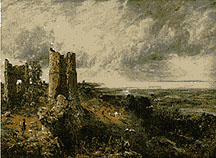The Romantic Era
 As the many socio-political revolutions of the late eighteenth-century established new social orders and new ways of life and thought, so composers of the period broke new musical ground by adding a new emotional depth to the prevailing classical forms. Throughout the remainder of the nineteenth-century (from ca. 1820 to 1900), artists of all kinds became intent in expressing their subjective, personal emotions. "Romanticism" derives its name from the romances of medieval times -- long poems telling stories of heroes and chivalry, of distant lands and far away places, and often of unattainable love. The romantic artists are the first in history to give to themselves the name by which they are identified.
As the many socio-political revolutions of the late eighteenth-century established new social orders and new ways of life and thought, so composers of the period broke new musical ground by adding a new emotional depth to the prevailing classical forms. Throughout the remainder of the nineteenth-century (from ca. 1820 to 1900), artists of all kinds became intent in expressing their subjective, personal emotions. "Romanticism" derives its name from the romances of medieval times -- long poems telling stories of heroes and chivalry, of distant lands and far away places, and often of unattainable love. The romantic artists are the first in history to give to themselves the name by which they are identified.
The earliest Romantic composers were all born within a few years of each other in the early years of the nineteenth century. These include the great German masters Felix Mendelssohn and Robert Schumann ; the Polish poet of the piano Frédéric Chopin; the French genius Hector Berlioz ; and the greatest pianistic showman in history, the Hungarian composer Franz Liszt.
During the early nineteenth century, opera composers such as Carl Maria von Weber turned to German folk stories for the stories of their operas, while the Italians looked to the literature of the time and created what is known as Bel canto opera (literally "beautiful singing"). Later in the century, the field of Italian opera was dominated by Giuseppe Verdi, while German opera was virtually monopolized by Richard Wagner.
During the nineteenth century, composers from non-Germanic countries began looking for ways in which they might express the musical soul of their homelands. Many of these Nationalist composers turned to indigenous history and legends as plots for their operas, and to the popular folk melodies and dance rhythms of their homelands as inspiration for their symphonies and instrumental music. Others developed a highly personal harmonic language and melodic style which distinguishes their music from that of the Austro-Germanic traditions.
The continued modification and enhancement of existing instruments, plus the invention of new ones, led to the further expansion of the symphony orchestra throughout the century. Taking advantage of these new sounds and new instrumental combinations, the late Romantic composers of the second half of the nineteenth-century created richer and ever larger symphonies, ballets, and concertos. Two of the giants of this period are the German-born Johannes Brahms and the great Russian melodist Peter Ilyich Tchaikovksy.
